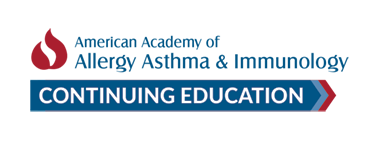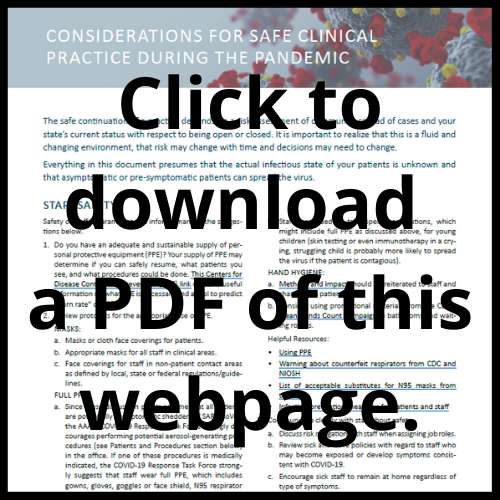Considerations for Safe Clinical Practice During the Pandemic
The safe continuation of a practice depends on a risk assessment of community spread of cases and your state’s current status with respect to being open or closed. It is important to realize that this is a fluid and changing environment, that risk may change with time and decisions may need to change.
The suggestions below have been drafted by the COVID-19 Response Task Force. Everything in this document presumes that the actual infectious state of your patients is unknown and that asymptomatic or pre-symptomatic patients can spread the virus.
STAFF SAFETY
Safety of staff is paramount and informs many of the suggestions below.
1. Do you have an adequate and sustainable supply of personal protective equipment (PPE)? Your supply of PPE may determine if you can safely resume, what patients you see, and what procedures could be done. This Centers for Disease Control and Prevention (CDC) link contains useful information on what PPE is necessary and a tool to predict “burn rate” of PPE.
2. Review protocols for the appropriate use of PPE.
Masks:
- Masks or cloth face coverings for patients.
- Appropriate masks for all staff in clinical areas.
- Face coverings for staff in non-patient contact areas as defined by local, state or federal regulations/guidelines.
Full PPE:
- Since these discussion points assume that all patients are potentially asymptomatic shedders of SARS-CoV-2, the AAAAI COVID-19 Response Task Force strongly discourages performing potential aerosol-generating procedures (see Patients and Procedures section below) in the office. If one of these procedures is medically indicated, the COVID-19 Response Task Force strongly suggests that staff wear full PPE, which includes gowns, gloves, goggles or face shield, N95 respirator and shoe coverings. Rooms need complete cleaning after such procedures are done (see Cleaning Resources below). Exceptions may be considered for patients who have recently tested negative for SARS-CoV-2.
- Staff may need to take special precautions, which might include full PPE as discussed above, for young children (skin testing or even immunotherapy in a crying, struggling child is probably more likely to spread the virus if the patient is contagious).
Hand Hygiene:
- Methods and impact should be reiterated to staff and shared with patients.
- Consider using promotional materials from the CDC’s Clean Hands Count Campaign in bathrooms and waiting rooms.
Helpful Resources:
- Using PPE
- Warning about counterfeit respirators from CDC and NIOSH
- List of acceptable substitutes for N95 masks from the FDA
- Infection prevention measures for patients and staff
3. Communicate clearly with staff about safety.
- Discuss risk mitigation with staff when assigning job roles.
- Review sick and leave policies with regard to staff who may become exposed or develop symptoms consistent with COVID-19.
- Encourage sick staff to remain at home regardless of type of symptoms.
- Address continuing risk mitigation outside of the office.
4. Be prepared in case staff is exposed or becomes infected.
- Know how to handle potential exposures at work.
- Consider availability of backup staff if one or more of your employees needs to be excluded from work.
PRACTICE SPACE LOGISTICS
Plan to make adjustments to the practice layout and cleaning procedures.
1. Review the physical structure of the office.
- Waiting room chairs six feet apart, with tissues and cleaning wipes readily available.
- Consider tape on the floor for physical distancing, and/or signage for the check-in queue.
- A limited appointment template may be needed to compensate for reduced waiting area space.
- Consider limiting the number of people per visit (no additional children, one accompanying adult for a child or adult).
2. Clean the office before you open and daily thereafter.
- Frequently touched surfaces may need to be cleaned more often. CDC guidelines mention wiping down frequently touched surfaces as often as after every use, but the frequency will depend on the ability of the staff to perform the task and the availability of disinfection solutions and/or wipes. Frequently touched surfaces in patient rooms may need to be cleaned after each use.
- Helpful Resources:
- The CDC has released guidelines for cleaning and disinfecting.
- A list of disinfectants approved by the Environmental Protection Agency (EPA) can be found here.
- A graphic for guidance on cleaning can be found here.
3. Regularly review and monitor safety and prevention procedures implemented in your office to optimize mitigation efforts as well as staff and patient safety. Modifications (less or more intense) may be warranted as local pandemic conditions change. Close monitoring of local, state and federal safety and prevention recommendations will help guide individual practices. Considerations for increasing the number of patients seen include staff’s performance with office precautions and the improvement of the pandemic within your community.
PATIENTS AND PROCEDURES
1. Determine which patients will be seen, which patients can use telemedicine, and which patients can wait longer for their appointment. Define criteria with staff to decide which types of patients need an in-person appointment, virtual appointment or delayed appointment. Remember, the final arbiter of these decisions is the physician or practitioner.
2. Consider protocols for screening patients before and at the time of arrival, including:
- Calling the night before, querying symptoms, and informing patient of expectations: face covering and hand hygiene. Suggest that patients bring in their own albuterol MDI in case treatment is necessary in the office.
- Screening at the door can include symptom checks, contact evaluations, cloth face coverings, education about touching face, hand hygiene, and limiting accompanying family or friends.
- Helpful Resources:
3. The COVID-19 Response Task Force has assessed the risk of performing many procedures we commonly perform in allergy/immunology clinics in light of COVID-19. There is little scientific data to help support our considerations for these procedures, so the Task Force chose the most conservative approach. These may change as the science becomes available. The table below categorizes these procedures according to risk, but it is not inclusive of all procedures you may consider performing.
The COVID-19 Response Task Force discourages performing high risk procedures in the office. Consider use of peak flow meters or mobile/digital devices the patient can use at home for monitoring lung function, some of the evaluation can then be done virtually. Examples of home spirometers include Wing by Sparo Lab, Zia Health Management wireless in-home spirometer and home monitoring, Microlife Digital PEF and FEV1, and MIR SmartOne. (The AAAAI does not endorse any manufacturer. This list is only for your information and may not include all devices currently available.)
The COVID-19 Response Task Force discourages the use of nebulizers in the office (high risk), so an office needs a supply of MDIs with spacers for patients who do not bring in their albuterol MDIs (or do not have one). Patients on immunotherapy or biologics should also be instructed to bring their albuterol MDI to the office with them.
4. Be familiar with the COVID-19 testing criteria and availability in your area of practice. Current CDC recommendations are available at this website.
ADDITIONAL RESOURCES
CMS recommendations on re-opening healthcare facilities to provide non-emergent care
Roadmap to Recovery: A Public Health Guide for Governors from the National Governors Association and Association of State and Territorial Health Officers
Coding Specific to Coronavirus Diagnosis, Testing and Telemedicine

 Facebook
Facebook X
X LinkedIn
LinkedIn Forward
Forward